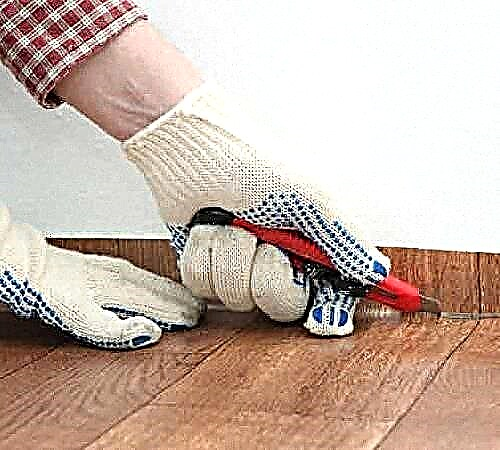When planning the arrangement of floor heating in an apartment or a private house, it is important to choose the type of system correctly and not make a mistake with the finish. Otherwise, the proper level of heating efficiency will not be achieved. The tile for a heat-insulated floor is the ideal decision in every respect. To make the best choice, you should familiarize yourself with the assortment and features of products on the market.
Types of laying of underfloor heating

The consumer is presented with a wide selection of systems that can be used for the construction of a warm floor.
The water circuit is equipped in private mansions and with the permission of the management companies on the first floors of apartment buildings. The line is laid by a snake or spiral on a heat insulator, and then poured with a cement screed. The advantage of this solution is that it is economically viable; the water stores heat for a long time after turning off the circuit with a thermostat.
Electrical products do not have restrictions on the installation site. Installation can be carried out in residential and utility rooms, balconies and loggias.
Systems are divided into such varieties:
- Cable. They are single-core and two-core resistive and self-regulating (matrix) wires with a thickness of 4-8 mm.
- Matt They look like canvases where a heating wire with a diameter of up to 4 mm is embedded in a plastic mesh.
- Infrared They are made in the form of a film, inside of which are carbon fibers that emit infrared radiation when current is passed.
Communications of the warm floor are installed under the screed, in its array or on the outer surface. The latter method is most effective, since it allows you to use all the heat produced by the system.
Decorative Coating Options

When choosing a floor covering, a number of factors must be taken into account that affect the efficiency of heating a room and the people living in it.
Products must comply with the following parameters:
- resistance to high temperatures,
- immunity to continuous heating and cooling,
- high thermal conductivity
- environmental Safety,
- installation technology
- convenience of service
- strength,
- durability,
- resistance to abrasion and chemically active substances,
- texture, color and surface design.
Since flooring has been installed for decades, the last thing you need to think about is the cost of materials. It is better to choose an expensive, but high-quality coating, the state of which will not need to worry until the next major overhaul of the building.

The best finishes that are used when installing underfloor heating:
- Ceramic tile. The material has a relatively low cost, high thermal conductivity, heats up quickly, transferring energy with virtually no loss. On sale is an extensive range of products of this type, characterized by various design solutions. The downside is that the outer decorative layer erases over time, and objects falling on the floor leave clearly visible chips on the surface. Tiles of 5-6 hardness class, 4-5 wear resistance class and water absorption of 3-6% should be chosen.
- Porcelain tile. This is a more durable coating, but its cost is higher. The material has a uniform structure throughout the volume, so that mechanical damage is not noticeable on its surface. High thermal conductivity of porcelain stoneware ensures efficient heat transfer from the heating element to the room. The downside is that the coating imitates natural stone - this option is poorly suited to the design of living rooms.
- PVC tile. Warm floor tiles without heating preserves performance at any temperature, including negative. Its distinctive feature is a pleasant tactile sensation even when the heater is off. When heated, the material does not emit harmful substances. An average level of thermal conductivity allows laying tiles directly on cable mats or infrared film. Warm floor tiles are easy to install, even a beginner can easily cope with this process.
- Vinyl tile. Warm vinyl floor tiles are an excellent solution for decorating a bedroom, kitchen, or even a room for a child. Vinyl flooring has a multilayer structure with an adhesive backing. It can be glued immediately after removing the protective film without the use of cement mortar or liquid nails. Ceramic inclusions provide high wear resistance of products, and ultraviolet treatment - preservation of color throughout the entire period of operation. Warm tile does not change its properties when heated
The priority when choosing should be given to material that can provide efficient heating with minimal electricity consumption.
Advantages and disadvantages of tiles for underfloor heating

If we generalize the performance characteristics of the coating for a warm floor, we can distinguish the characteristic pros and cons inherent in all types of materials that are used in residential premises.
Among the advantages include:
- strength,
- water resistant
- good thermal conductivity
- variety of textures
- wide selection of colors
- ease of installation
- durability,
- dielectric qualities
- ease of cleaning from contamination.
The material has its drawbacks. The main thing is the presence of seams that are visually visible and feel to the touch. Tiles and porcelain tiles when the heater is turned off become cold and unpleasant to walk. Tiles crack when solid objects fall on it. If there is no stock, replacement can cause serious difficulties.
Material Features

Tiles and porcelain tiles have almost the same technical characteristics. The difference is only in composition, hardness and porosity. At the same time, both materials are excellent conductors in direct-acting structures. The floor, covered with hard tiles, is able to qualitatively heat the room even in stand-alone mode without wall radiators. However, such a coating requires a high-quality and sensitive thermostat. Good conductivity can cause overheating. Comfortable is the temperature of the floor in the range of 23-28 degrees.
Tiles made of vinyl and PVC have less thermal conductivity. On the one hand, this is good, since a critical temperature increase is excluded. On the other hand, more energy is required to ensure a comfortable indoor environment. Synthetic coating responds better to shock, cushioning under heavy loads.
Mounting methods for selected items
Installation methods vary significantly depending on the composition and shape of the elements of the floor heating. One thing is common in all cases - high-quality leveling of the base and its primer to improve adhesion.
Tiles and porcelain tiles are laid on glue, the basis of which is cement. It is possible to use mortars packaged in tubes; it is faster, easier, but more expensive. Laying is carried out in even rows, with offset or diagonally. Equalization is achieved using plastic crosses. After the solution solidifies, they are removed, and the seams are overwritten.
The polymer fragments are fixed on the plate on an adhesive back-to-back basis or are fastened directly to the screed by the floating method. In this case, gluing is performed only on the chamfers at the edges of the products.
What to choose to warm your feet: floor tiles or porcelain tiles?
As a rule, when choosing a material for the floor, an important dilemma arises for the client: do you prefer ceramic tiles or porcelain tiles? And which of the presented materials will be warmer and more comfortable, because we are talking about finishing the floor in the living room. Let's figure it out!
To understand which material is warmer, you need to determine their differences.
Previously, when porcelain stoneware just appeared on the market, there was a myth among consumers and even sellers that it was made from more “progressive” ingredients than ceramic tiles. And these secret ingredients make it better, stronger and more modern than the “younger sister”. But this is not so! No secret components in porcelain stoneware are “mixed”. It consists of the same elements as the tiles: the same feldspar, kaolin, quartz sand and clay.

The main difference is the production technology. Ceramic granite is fired under the influence of higher temperatures (about 1300 degrees), and a much higher pressure is applied (about 450 kg per centimeter). It is the production technology that contributes to more “progressive” quality indicators of porcelain stoneware: high temperatures literally melt and tightly glue the components, and pressure does not allow micropores to form. The absence of micropores explains the durability, frost resistance, moisture resistance and strength of this material.
Such qualities make ceramic granite an ideal solution for decorating building facades, terraces, street stairs, etc. But do they allow you to “win” the title of the ideal flooring solution for living space? Indeed, in an ordinary apartment it is not so important that the floor is frost-resistant! It is much more important that it is warm and comfortable!

Is the thermal conductivity of a conventional tile high?
Floor tiles are usually laid with tile adhesive on a concrete screed. This symbiosis has the ability to accumulate heat and transfer it to the air. Therefore, the tile quickly heats up, but just as quickly and cools in an unheated period. This material has an average coefficient of thermal conductivity, but in combination with other building materials it is at a sufficient level to provide comfort.

Is the thermal conductivity of porcelain stoneware high?
Ceramic granite boasts a very low thermal conductivity. If the product is heated, the heat in it will remain for a very, very long time. In summer, it takes the temperature of the room and you can comfortably walk on it barefoot. And to be comfortable in the winter, you should use the "warm floor" system. This solution can rightfully be considered the best for use in residential space.

Given the thermal conductivity coefficients of the presented finishing materials, we conclude that porcelain stoneware is neutral to temperature changes, unlike tiles. And when used in tandem with the “warm floor” system, it provides comfort and coziness in the house!
Attention, if you have repairs in your house and you select high-quality flooring, pay attention to the following collections fromKeramaMarazzi in assortment: "Frigate», «Corvette», «Elm», «Yakaranda"And others. The texture of the wood will make the material even more comfortable!
Features
Floor tiles retain heat by filling ceramic material with air bubbles. Due to this, a heat-insulating layer is formed, which allows the tile to remain warm without heating.
Accordingly, by installing such tiles in the bathroom, bathrooms, corridor or kitchen area, you will be spared the need for additional installation of underfloor heating systems or the purchase of carpets.
Warm tiles are made from ceramic foam, before a similar solution was used to warm the stoves. The strength of the material is achieved by calcination, which decomposes organic compounds. The operational characteristics of the material depend on the structure, the number of bubbles, their size and the features of their location.
Warm ceramic tiles are presented on the building materials market in a wide assortment: with various technical and operational characteristics. So, for outdoor use foamed ceramics with low porosity is produced, made using special technology that allows to increase the tile resistance to high mechanical loads.
If the room has a large cross, you need to choose a floor covering with high resistance to wear.


Advantages of warm tiles
In favor of choosing a warm tile speaks a number of positive characteristics that are inherent in it:
- special spraying with antibacterial properties,
- resistance to mechanical stress,
- a porous structure that gives the tile a low degree of thermal conductivity (a rough surface with a noticeable relief transfers less heat to the foot than smooth),
- resistance to pollution and adverse environmental influences: moisture, UV rays, aggressive environment,
- environmental friendliness, the absence of components harmful to humans,
- huge range: various forms, textures, shades.
Among the shortcomings of warm ceramic tiles can be noted its high cost: from $ 100 per 1 m2.
Ceramic foam can be combined with a water or electric floor heating system. Due to the low thermal conductivity, a warm tile will consume a minimum amount of energy, while ensuring sufficient heating of the floor surface.


Varieties
Most often, warm ceramic and porcelain tiles, as well as ceramic parquet, are used for residential premises. However, there are other varieties.
Pvc tile began to use recently. Most often it is used in the kitchen and in bathrooms, warehouses, public and industrial premises, garages. The price of this material is significantly lower in comparison with porcelain counterparts, but the service life is less.
PVC tile is durable, but after a while loses its attractive appearance.

Among the advantages of such tiles can be noted:
- ease of transportation
- high strength
- good sound insulation
- wide range of textures and color options,
- high moisture resistance.
- the possibility of re-installation when peeling off,
- anti-slip coating,
- easy to cut.


The disadvantages of PVC tiles include its artificial base. The apartment is recommended to use natural finishing materials. Recently, designers are increasingly using PVC tiles that mimic natural stone.


For the decoration of living space, commercial and industrial enterprises, another type of material can be used - warm vinyl tile. You can purchase a high-quality and certified product in large construction stores and from official representative companies.
The material can be combined with additional floor heating systems.
Recommended temperature fluctuations of vinyl tiles can be: up to + 32 degrees in the bathroom and pool, up to + 29 in other rooms.


Selection tips
Warm tile goes well with any design elements, so there are no restrictions on its choice: you can use any shade, pattern and size. However, when choosing a floor covering, it will not be amiss to take into account the size of the room where the installation will be made, lighting features and the general style.
When choosing a material, you must pay attention to the following specifications:
- strength,
- heat capacity,
- electrical insulation properties
- fire safety
- wear resistance


- antistaticity
- rigidity,
- hygiene
- friction index
- porosity (the lower it is, the stronger and frost-resistant the material),
- resistance to chemicals.
When to choose
Warm tiles must be selected in the process of creating a design project to make the necessary calculations. If at the design stage the selection of tiles is not possible, then you need to calculate the flooring based on the worst parameters.
Most likely, this will affect the cost overrun of the material in the future, but it will be possible to save on floor heating.

Installation Nuances
Warm ceramic tiles have some nuances in the installation process. This applies to the features of the laying of the material and its seamless docking. Since the material tends to expand during heating, this can lead to cracking. To avoid adverse effects, it is necessary to choose the right adhesive mixture. In rooms with a high level of humidity, it is recommended to use a two-component adhesive base.
Detailed information on the features of temperature fluctuations is indicated on the packaging of the adhesive. Most often, tile installers use epoxy.
You can prepare the floor for installing the coating yourself, following the instructions, but it is best to leave this work to professionals to avoid mistakes. Communications and wiring must be well secured and removed.. During installation, it is necessary to control that there are no air gaps under the coating, otherwise in the future their presence will lead to a breakdown of the heating system.


What is a warm floor tile
The effect of a heated surface is created due to the presence of small air pores in the tile. The fine-meshed structure is formed as a result of the application of special technology or the use of porous natural materials. Air bubbles are distributed evenly throughout the volume and serve as a good insulator.
The use of floor panels made of a material with low thermal conductivity creates a double positive effect. When touching, there is no feeling of cold, walking without shoes becomes pleasant. It is easier to maintain a comfortable temperature in an apartment or house.
Underfloor heating can be installed in residential and auxiliary premises. It is especially nice to walk along it in the cool corridor, in the bathroom, in the kitchen.
Pros of warm tiles
• the porous structure gives the material heat-insulating properties; when it comes in contact with the tile, cold is not felt,
• thanks to innovative technology, the floor covering is sufficiently resistant to mechanical stress,
• a special protective coating has an antibacterial effect,
• ceramics contain no toxic components hazardous to the health of households,

• the tile is resistant to pollution and the effects of external factors (ultraviolet, moist and aggressive environment),
• a large assortment of floor ceramics of different textures, sizes and colors is produced, which allows you to choose the most successful option for a certain interior style.

The disadvantages of new products are still difficult to assess, because they have not yet passed the main test - a consumer test. But now you can testify to the high price, which starts at $ 100 per square meter.
Warm ceramics are ideal for arranging a warm floor in combination with an electric or water type heating system. Its thermal conductivity indicators will help to minimize energy consumption, while ensuring a sufficiently good heating of the floor surface. Experts recommend giving preference to ceramic tiles.

Porcelain tile has styling features, in addition, the installation technology provides for seamless joining. However, during heating, the material expands, which provokes the formation of cracks. The quality of the laying is also affected by the adhesive mixture, so when choosing glue, you should pay attention to the information on the packaging regarding the temperature fluctuation cycles. In most cases, craftsmen prefer epoxy.



